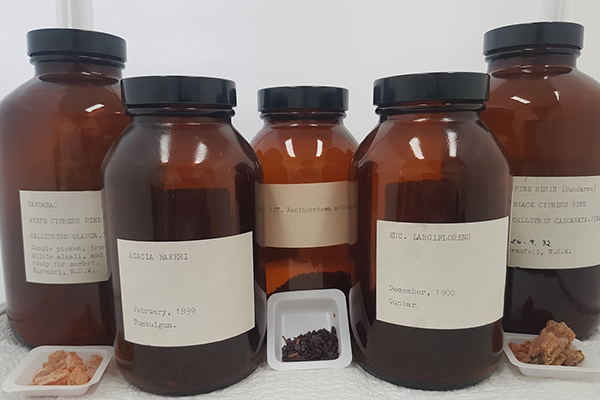Synchrotron technology shines a light on Australian plant exudates
For the first time, scientists have used synchrotron technology and laboratory-based analytical approaches to study the unique properties and applications of Australian plant exudates (gums, resins and kinos).
The paper, published this week in PNAS, utilises a unique approach integrating complementary analytical methods to analyse samples from a historical collection to reveal the exudates’ chemical characterisation from fundamental atomic bonding to the molecular structure.
Co-author, Professor Rachel Popelka-Filcoff from the School of Geography, Earth and Atmospheric Sciences at the University of Melbourne, said these physicochemical analyses of cultural heritage materials provide insights into their technical and cultural uses in the archaeological and historical record.
“This study opens new opportunities for analysis of cultural heritage items in museums, cultural collections and art galleries worldwide. The chemical composition and material properties of exudates often determine their cultural use, so it is not surprising that natural materials used over thousands of years of tradition continue to inspire their current and future uses,” Professor Popelka-Filcoff said.

Historical samples of plant exudates taken at Flinders University
The research examined examples of four genera native to Australia: Xanthorrhoea, Callitris, Eucalyptus and Acacia, each of which has unique chemistry and structure.
Xanthorrhoea are phenolic resins, frequently used in hafting due to their adhesive properties. Similarly, Callitris are diterpenoid resins that also have binding properties and can be used as a binding agent or varnish.
Eucalyptus kinos are composed of tannins, phenolic and other aromatic constituents, which gives them astringent properties. Acacia gums are polysaccharide gums and therefore act as biopolymers that can act as emulsifiers for pigments, making them useful for cosmetic and art applications.
Synchrotron technology, which accelerates electrons to almost the speed of light, offers several distinct capabilities that differentiate the results from traditional laboratory-based methods.
“Synchrotron radiation is “brighter” than laboratory-based methods, providing a higher signal to background ratio and can be tuned to specific wavelengths and utilise physical properties such as scattering to analyse materials,” Professor Popelka-Filcoff said.
“Importantly for the analysis of cultural materials, synchrotron methods can be designed to be non-destructive and non-invasive to the object analysed, and the object can be returned unharmed. “
In recent years, synchrotron-based approaches to cultural heritage analysis have illuminated a diversity of approaches across a range of applications, including identifying hidden paintings under layers and the non-destructive analysis of the composition of pigments on paintings.